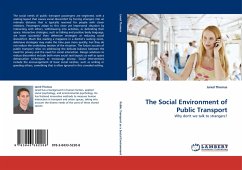The social needs of public transport passengers are neglected, with a seating layout that causes social discomfort by forcing strangers into an intimate distance that is typically reserved for people with closer relations. Passengers adapt to this close yet impersonal situation by interacting with others, withdrawing into activities, or defending their space. Interactive strategies, such as talking and positive body language, are more successful than defensive strategies at reducing social discomfort. Much like reading a magazine in a dentist's waiting room, defensive strategies may make the time pass more quickly, but they do not reduce the underlying tension of the situation. The future success of public transport relies on addressing the delicate balance between the need for privacy and the need for social interaction. Design solutions to reduce discomfort include both more social seat layouts as well as space demarcation techniques to encourage privacy. Social interventions include the encouragement of basic social niceties, such as smiling or greeting others, something that is often ignored in this crowded setting.
Bitte wählen Sie Ihr Anliegen aus.
Rechnungen
Retourenschein anfordern
Bestellstatus
Storno








